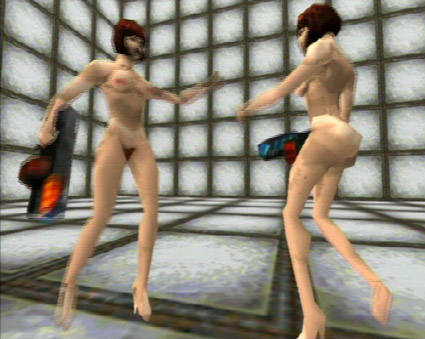 |
Linda Erceg, Skinpack 2000 |
In Skinpack 2000, Melbourne-based artist Linda Erceg has modified the Quake 2 game engine using pornographic shareware and deconstructive editing techniques to satirically overplay the violent, sexualised agencies and objectives of first person shooter games. Modded avatars like Crack Whore, Chastity Marks and Nude Chick wear clichéd buxom nude skins, all pulled from Quake 2 fan-sites, crouch, duck, and splay their fannies in long episodes of masturbatory gun-play. The codes of subjectivity in first person shooter genres are further disturbed: the ‘I’ identifying gun barrel close-up is often absent; shooting between all players is unnervingly put off for long periods; and when shots are let fly, killing is slow, nonsensical (moreso because of the viewer’s uncertain orientation) and jackhammer-loud against the eerie silence of the game/gallery environment. Meanwhile, close-ups and disorienting points of view voyeuristically immerse the viewer in the action (or its absence). If you hang around long enough, despite the lack of narrative connection between various players, every girl eventually dies in a naked heap of clunky, low-polygonal-count reality. A glitchy and unnervingly ambiguous all-girl, go-nowhere act, this highly choreographed work throws into stark relief some of the more disturbing codes of immersion and performance embedded in First Person Shooter game culture.
Mechalust is about machines, but it is also about artists themselves, and their passions—the kinds of identities that are forged from personal histories spent producing and consuming virtual pop-cultures. SomeGuy’s 8 Bit E-Motion Comik is a self-published net-based geek’s soapie (www.wearethestrange.com -expired). Heavily plumbing the visual styles and romantic narrative conventions of anime works like Battle Angel Alita, this Californian artist’s self-confessed fantasy girl, ‘Blue Wander’, travels through a strange robotic underworld, and over 9(!) melodramatic episodes, escapes the clutches of Star Trek-style robot foes and monstrous n’er-do-wells on her journey towards self discovery and true love.
Gaunt, widescreen shots of the blue-black haired heroine drive a somewhat patchy narrative and are overlaid with a dissonant Commodore 64 soundtrack and eerie, cliched subtitles, like: “Someday you will find a voice and sing a beautiful song that will change the whole universe.” It’s awkwardly clunky, amateur and mishmashy—part comic, part cartoon of 3D, 2D and claymation techniques—but it’s also richly pop-referential, beautifully drawn in parts, and sincerely affecting.
Also very much within the Automated Lovers’ theme was Tetsuo Takahashi’s G-Spot-Pleasure of a Japanimation robot. Tetsuto positions himself as a self-reflexive Otaku, making independent erotic art for mecha-Otaku’s (lovers of anime with a particular penchant for robot mechanics). “I want to find the G-spot of mecha-Otaku, and why they love Japanimation robots like Gundam. The study of mecha-Otaku is also the study of myself, because I grew up in Otaku culture.” Exhibited across 3 horizontally aligned projection screens, G-Spot consists of hundreds of freeze-frame still images of a single, intricately rendered Japanimation robot made by the artist with 3D CG software. Perhaps Maya? Each image closes in on body parts in masterful detail, unashamedly emphasising the masculine capabilities and aesthetic beauty of head, torso, sword-wielding fists and a massive flailing penis. Also within the slide collection are partially rendered sketches of a robot in development. It’s incredibly detailed work; tiny screws, shadows, and reflections of other body parts are visible even upon the metallic surfaces of his body. Collectively, the 3 carousels of images provide a disorganised narrative montage of swordplay and general might, in which the robot finally masturbates to climax all over himself and then commits harikari.
The ‘Otaku’ label is derisory in Japan, and the artist’s own mechalust is hardly the norm, let alone an acknowledged meme of discussion in Otaku culture. But Tetsuo’s artist statement goes beyond reclaiming words and divesting the Otaku of self-loathing, towards a revolutionary homoeroticisation and politicisation of current forms of mecha-Otaku subjectivity: “After (the robot’s) destruction it is reborn. To let the Otaku see the world in new ways, we need to crush and reconstruct the Otaku’s conservative nature with our own hands. This era demands a new breed of Otaku. Otaku must be reincarnated as the New type. Otaku, wake up now!” The choice to exhibit such masterful, high-tech artistry depicting such antiquated technology is what makes this work most interesting. Instructional, clinical, masculine, and emphasising a moment of past production, the slide show format intimidatingly frames the artist as a master of CG art, and exaggerates the masculine exhibitionism inherent within the work itself.
The Straight Out of Brisbane program gives equal importance to both the critical discussion of artists’ practices in context and the display of finished works. This combination of skills workshops, panels, and exhibitions in temporary galleries worked well in packaging Kirsty Boyle’s multi-layered practice. Her ‘Girltron’ photographic prints Dolls in Space made less rewarding viewing as art objects in themselves but the premise is clever fun—a recombinatory gluing together of ‘boys toy’ body parts (robot), with girl toy’s heads (dolls) as part of a practice that the artist conspicuously labels ‘toy hacks.’ (Additional toyhack sculptures were also constructed by workshop attendees during the festival, and added to the Mechalust exhibition space.) It’s a very material, feminine and tactile redefinition of hacking which, interestingly, entirely bypasses coding—that back-end, practice/habitat of electronics and computer programming overrun by masculine forces. For festival-goers who managed to attend the Mechalust-related panel and workshops, Kirsty’s background in Linux ladies user groups and her anthropological studies into robot cultures like Karakuri added important layers of meaning to her art practice, and to the exhibition as a whole.
Mechalust, curator Thea Baumann; TC Beirne Centre, IMA, Visible InK (Brisbane City Council); 2004 Straight Out Of Brisbane; December 5-8, 2004
Rachel O’Reilly is a writer, editor, former festival manager (This Is Not Art) and Film, Video, New Media Intern at the Queensland Art Gallery/Queensland Gallery of Modern Art.
RealTime issue #65 Feb-March 2005 pg. 30
© Rachel O'Reilly ; for permission to reproduce apply to [email protected]








 back
back